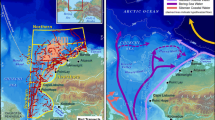Abstract
In St. Margaret's Bay, Nova Scotia, Canada, there are large areas in which sea urchins (Strongylocentrotus droebachiensis) have eliminated beds of kelp (Laminaria spp.). Sites were identified where destruction of kelp beds had taken place 1, 2, 3, 3.5 and 4 years ago. With increase of time since kelp disappearance, the sea urchins showed decreased growth rate, reduced gonad size, but an increase in numbers resulting from high recruitment rates in the first two years after kelp bed destruction. These sea urchin populations, by their browsing, effectively prevent the regeneration of kelp. There is, as yet, no evidence of the sea urchin populations being starved out to allow the kelp to return.
Similar content being viewed by others
Literature Cited
Breen, P.A.: Relations among lobsters, sea urchins and kelp in Nova Scotia, 190 pp, Ph.D. thesis, Halifax, Nova Scotia. Dalhosie University 1974
— and K.H. Mann: Changing lobster abundance and the destruction of kelp beds by sea urchins. Mar. Biol. 34, 137–142 (1976)
Gonor, J.J.: Goriad growth in the sea urchin Strongylocentrotus purpuratus (Stimpson) (Echinodermata: Echinoidea) and the assumptions of gonad index methods. J. exp. mar. Biol. Ecol. 10, 89–103 (1972)
Jensen, M.L.: Age determination of echinoids, Sarsia 37, 41–44 (1969)
Jones, N.S. and J.M. Kain: Subtidal algal colonization following the removal of Echinus. Helgoländer wiss. Meeresunters. 15, 460–466 (1967)
Kitching, J.A. and F.J. Ebling: The ecology of Lough Ine. XI. The control of algae by Paracentrotus lividus (Echinoidea). J. Anim. Ecol. 30, 373–383 (1961)
Leighton, D.L.: Grazing activities of benthic invertebrates in Southern California kelp beds. Nova Hedwigia (Suppl.) 32, 421–453 (1971)
Mann, K.H. and P.A. Breen: The relation between lobster abundance, sea urchins, and kelp beds. J. Fish. Res. Bd Can. 29, 603–609 (1972)
Miller, R.J. and K.H. Mann: Ecological energetics of the seaweed zone in a marine bay on the Atlantic coast of Canada. III. Energy transformations by sea urchins. Mar. Biol. 18, 99–114 (1973)
—— and K.H. Mann and D.J. Scarratt: Production potential of a seaweed-lobster community in eastern Canada. J. Fish. Res. Bd Can. 28, 1733–1738 (1971)
Nie, N.H., C.H. Hull, J.G. Jenkins, K. Steinbrenver and D.H. Bent: Statistical package for the social sciences, 675 pp. New York: McGraw-Hill Book Company 1975
Paine, R.T. and R.L. Vadas: The effects of grazing by sea urchins, Strongylocentrotus spp., on benthic algal populations. Limnol. Oceanogr. 14, 710–719 (1969)
Author information
Authors and Affiliations
Additional information
Communicated by T.R. Parson, Vancouver
Rights and permissions
About this article
Cite this article
Lang, C., Mann, K.H. Changes in sea urchin populations after the destruction of kelp beds. Marine Biology 36, 321–326 (1976). https://doi.org/10.1007/BF00389193
Accepted:
Issue Date:
DOI: https://doi.org/10.1007/BF00389193




